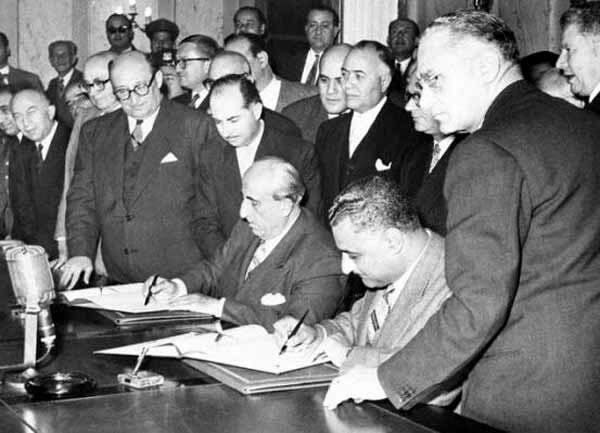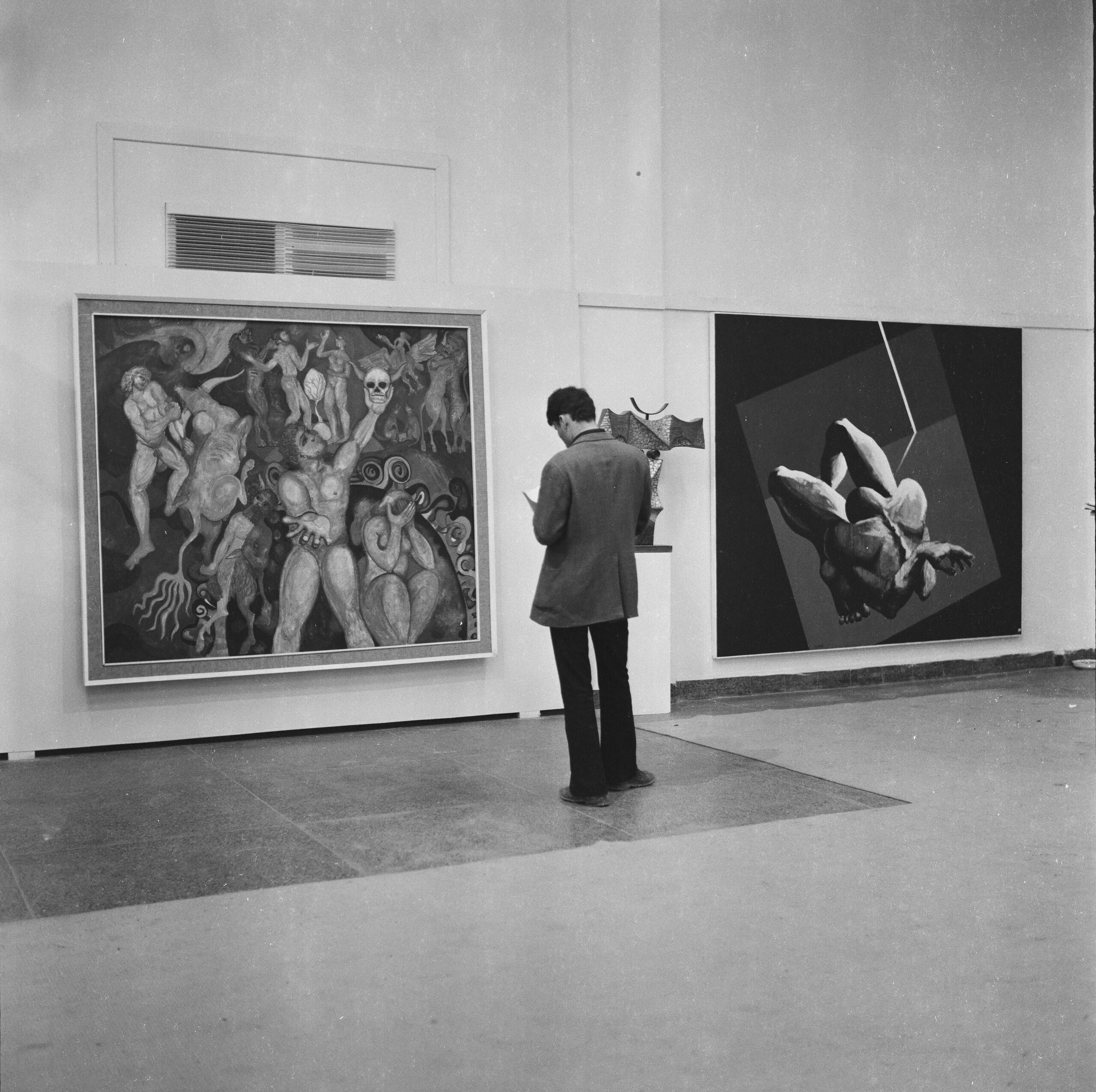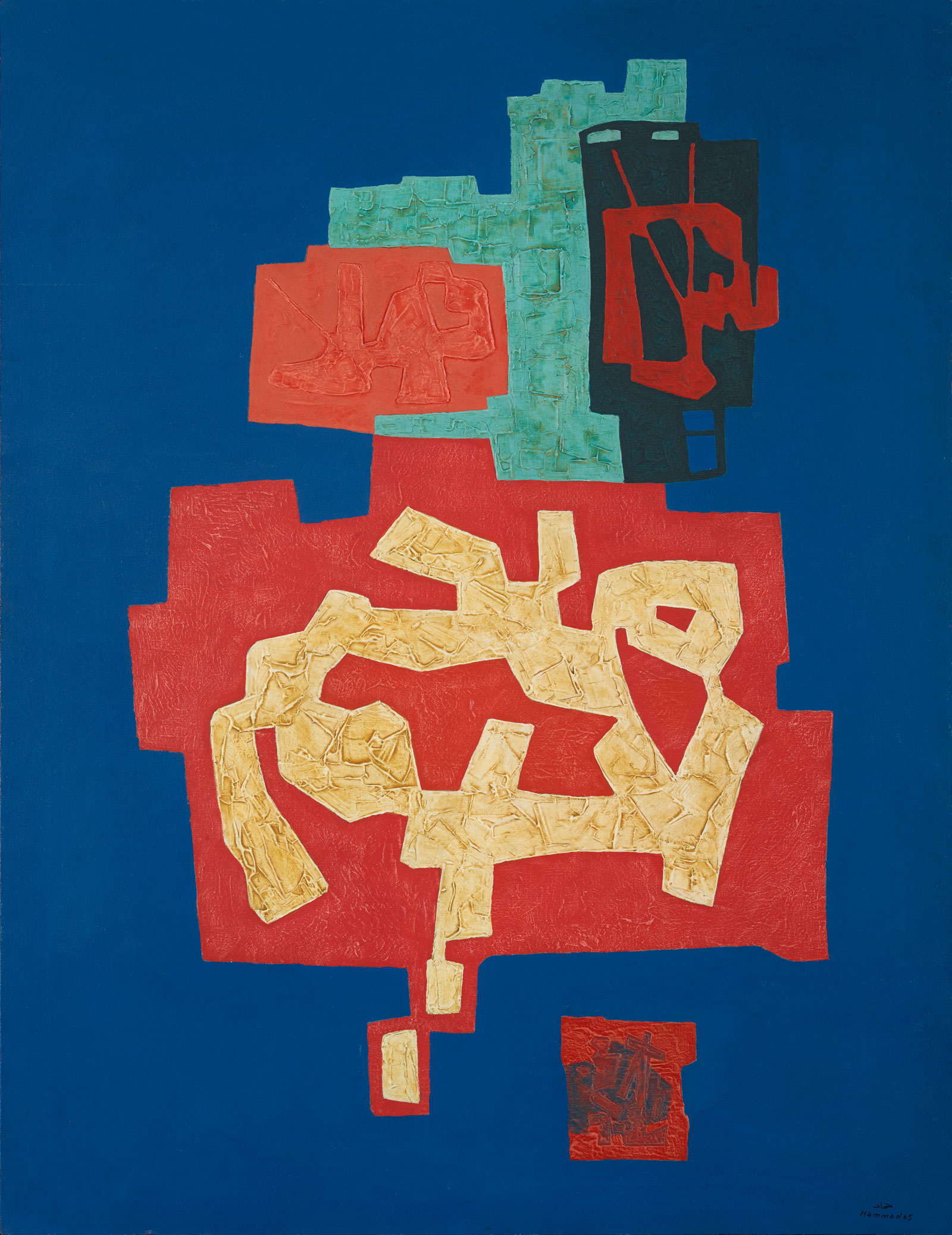It is true that the word ‘diversity’ can perfectly characterize the multiple populations coexisting in the countries of the MENA (Middle East-North Africa) region. In fact, there are effectively various ethnic (Arabs, Circassians, Berbers, Kurds, Armenians) and religious (Sunnis, Shiites, Christians, Alawites) groups. Yet, the post-colonial era reveals successive attempts at uniting these populations under a more general and common identity. In
February 1958, the United Arab Republic was proclaimed by both Egyptian president Gamal Abdel Nasser (1918-1970) and Syrian president Shukri al-Quwatli (1891-1967). This marked a political union between Egypt and Syria (fig.1). Soon after, the Arab Federation was founded by King Faisal II of Iraq (1935-1958) and King Hussein of Jordan (1935-1999). Lastly, the Federation of Arab Republics was initiated in 1971, uniting Egypt, Syria, and Libya.

Figure 1 Gamal Abdel Nasser (1918-1970) and Shukri al-Quwatli (1891-1967)
signing the Syria-Egypt union pact on February, 2nd 1958.
Source: Wikimedia Commons
Although these ambitious initiatives did not last long, they represented greater willingness to form a united political front in the Middle East. More precisely, however, this formation was affiliated with the construction of the Arab identity. This concept holds a complex definition provided by French linguist and historian Maxime Rodinson (1915-2004): « (…) considérer comme appartenant à l’ethnie, peuple ou nationalité arabe ceux qui: « 1° parlent une variante de la langue arabe et, en même temps, considèrent que c’est leur langue « naturelle », (…); 3° (…) revendiquent l’identité arabe, ont une conscience d’arabité » [1]
The revindication of the Arab identity was shared by a large majority of artists in the MENA region during the 1960s and 1970s. The enthusiastic new regional dynamic led them to conduct research and experimentation, which would question their condition as ‘Arabs’. Their artworks, produced in the first half of the 20th century, were mostly tinged with a sense of localism (al-tabi’ al-mahalli), specific to the culture and history of their respective countries. Gradually, they initiated a trend, which progressed towards the Arabization (al-ta’rib) of the art practice. They developed a visual language inspired by the common culture and civilization, namely the Arab-Islamic. This involved an expansive audience – from North-Africa to the Middle East – and imposed itself as a form of regional art.
Hence, which similarities were the artists able to find among such differing populations? Considering the diversity of the MENA region, does a collective ‘Arab art’ exist? Disregarding labels, the interconnectedness of artists, politicians, and even intellectuals, definitely demonstrated a strong feeling of brotherhood, juxtaposing the dividing powers of the Cold War.
Strength in Unity: Empowering the Arab Nation
‘We asked God to aid us all in serving our Arab Nation’[2].
Founding Committee of the Union of Arab Plastic Artists, 1971
In parallel to the 1958 unification of the Middle Eastern countries, the development of connections between the plastic artists also illustrated this process of federation. To illustrate, the administrative power of the United Arab Republic was concentrated in Egypt, thus Syrian art students had to complete their studies in Cairo[3]. Yet, simultaneously, local artist associations like the Iraqi Artists Association (1956) and the Syrian Syndicate of Fine Arts (1969), existed at the time but worked independently. The idea to create a more powerful artists’ association was then progressively envisaged.
In December of 1971, the General Union of Arab Plastic Artists (al-Hay’a li-Ittihad al-Fannanin al-Tashkiliyyin al- ‘Arab) was founded in Damascus. Concurrently, Palestinian artist Ismail Shammout (1930-2006) became the first General Secretary. As such, the North African and Middle Eastern artists federated into one association under the banner of the Arab nation: “They [the Arab artists] have come together driven by a strong and honest desire, aiming to create a union that brings together Arab artists on a brotherly level, and within the nationalist framework to which they belong”[4].
The transregional union firstly integrated the following countries: Tunisia, Lebanon, Libya, Kuwait, Palestine, and Syria. Capital cities including Cairo, Beirut, Damascus, and Baghdad, became attractive hubs. There, Arab artists discussed theories and artistic programs with one another. They also actively presented their artworks in collective exhibitions such as the state-sponsored Al-Wasiti Festival (Mahrajan al-Wassiti) in Baghdad in April 1972, followed by the the First Arab Festival of National Plastic Art (al-Mahrajan al-‘arabi al-awwal li-l-fann al-qawmi al-tashkili) in Damascus in October of the same year. Consequently, the General Union of Arab Plastic Artists (al-Hay’a li-Ittihad al-Fannanin al-Tashkiliyyin al- ‘Arab) imposed the Arab world as a strong artistic and cultural pole in the international scene.
Then in March of 1974, the very first Arab Biennial (M’arid al-Sanatain al- ‘Arabi al-Awwal) (fig.2) was held in the Museum of Modern Art in Baghdad. It represented 14 countries and exhibited 600 artworks. This major event, symbolically labeled as ‘Arab’, proved the solid commitment of the organizers to defend the Arab cause. In fact, the biennial was given a political dimension, contrary to other Western biennials[5]. This manifested as participants debated their common expectations and responsibilities as Arab artists. Mohammed Chebaa (1935-2013) stated: “If we [Arab artists] want to get rid of foreign domination, then we must rid ourselves of it all fields[ , and especially in the field of culture (…)”[6]. It intentionally was not meant to take place only in one country, but to be itinerant in order to connect the Arab states. The two following editions then took place in Rabat (1976), and then in Tripoli, Libya (1980).

Figure 2 Baghad Biennale, 1974. Photograph: Mohamed Melehi.
Courtesy of M.Melehi estate/archives
Huroufiyah: Arabization (ta’rib) in Art Practice
Moving back to the 1960s, and despite political tension between some Arab countries, the Mashriq and the Maghreb were reunited around artistic creation, celebrating ‘Arabness’. This artistic creation was a common plastic language, which the Iraqi poet Buland al-Haidari (1926-1996) apprehended as a “new trail which would give concrete expression to the longing for Arab unity, and end by giving the Arab world an art of its own”[7].
In addition to the first Arab Biennial, there was an aspiration to Arabize the art practice. Aware of their uniqueness, the Arab artists from the 1960s and 1970s also knew of their similarities. Thus, they found inspiration in a collective cultural heritage, going back to the period of pre-colonization. They rediscovered the arts of Islam, which attest to the genius of the Arab people. This art also encompassed a vast artisan production, precious manuscript illustrations, calligraphy, and complex architectural décor. It is worth mentioning that the religious factor did not play a significant role in the search for the Arab artistic identity. It was in the arts of Islam that artists found the opportunity to include classical tradition in Arab modernity. Arabic script, which is part of this process used by all people in the MENA region, provided a wide scope for experimentation. This script was mainly produced by artists from Iraq, like Jamil Hammoudi (1924-2003), and Syria, such as Mahmoud Hammad (1923-1988). The compositions included Arabic letters, isolated or intertwined with each other, deprived from any literal meaning. The artists effectively initiated an innovative approach to the Arabic script, which is generically called huroufiyah. Nevertheless, they did not work as calligraphers, and their paintings like Écriture arabe op.11 (1965) (fig.3) were not about calligraphy. Different from the art of calligraphy (khatt), huroufiyah comes from the word hurouf (letters), and refers to the modern use of the Arabic letter in art practice.
Numerous theories questioned huroufiyah. They doubted whether it confirmed the continuation of Islamic identity or a more secularized one. Yet, what is certain is that the movement first reflected the plastic investigation on abstraction, conducted by the Arab plastic artists to affirm their Arab identity. Although huroufiyah did not generate an official artists’ group, it was identified as a “national pan-Arab product”[8].

Figure 3 Mahmoud Hammad, Écriture arabe op.11, 1965, oil on canvas,
130 x 100 cm.The Ramzi and Saeda Dalloul Art Foundation, Beirut, Lebanon.
The Fraternity of Arab Solidarity
In June of 1967, Israel won the Six-Day War against the Arab coalition (Egypt, Jordan, Iraq, Syria, Lebanon), and occupied some of its territories. The defeat was unbearable to the Arab States, which had never ceased to act in solidarity with the Palestinians since 1948. One of the most relevant examples of solidarity is the political stance of Algeria, which has always shown particular support to the Palestinian cause even till today[9].
At the first Arab Biennial, the Palestinian sector showcased about fifty figurative artworks, displaying a willingness to put art at the service of the Palestinian cause. The latter was among the main concerns of the expansive program of the General Union of Arab Plastic Artists in 1971. It was expressed that, “Arab plastic art is also a product of this Arab society facing, at its core, attempts to erase its Arab identity and civilization as well as its very existence, especially where the pivotal issue in the struggle for Arab liberation is concerned: namely, the issue of Palestine”[10].
Naturally, many Palestinian artists, such as Ismail Shammout (1930-2006) – also head of the Department of Art Education of the Palestine Liberation Organization (PLO) – and Sliman Anis Mansour (1947-), showed deep commitment in their paintings. However, the successive defeats that faced the Arab troops during the conflicts of the 20th century with the Hebrew state did not only affect Palestinian artists. These defeats left a bitter aftertaste in the regional environment, sometimes stimulating a remarkable shift in the work of some artists. They were pushed to contest the military expansion and occupation of Israel in their artworks. They chose to depict harrowing scenes, like Egyptian painter Samir Rafi (1926-2004), who executed the work Untitled (A Palestinian Scene) (fig.4) four years after the invasion of the Israeli troops in Sinai. The seal of Palestine was not one belonging to an isolated country, but that of the Arab nation, all of which had to join the fight. This solidarity among the Arab states could be explained by a shared sentiment of anti-colonialism oriented towards Israel, whose establishment in 1948 was viewed as a new settler in the region. They projected their respective colonial past on the Palestinian cause.
-Front.jpg)
Figure 4 Samir Rafi, Untitled (A Palestinian Scene), 1960, oil on canvas,
162 x 138.2 cm. The Ramzi and Saeda Dalloul Art Foundation, Beirut, Lebanon.
Prominent figure of Arab nationalism, Iraqi General Director for Education Sati’ al-Husri (1881-1968) distinguished two categories of national affiliation: one to the particular nation (al-watan al-khass) and one to the general nation (al-watan al- ‘aam)[11]. The latter would be an ideologized bigger nation, around which the population in the MENA region would gather, and identify. Through their works, the Arab plastic artists reinforced the concept of Arab identity, that stood in the face of the West.
Edited by Elsie Labban



Comments on The Arab Identity for a Regional Art